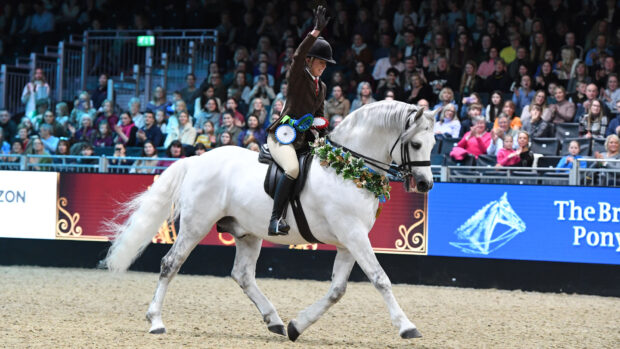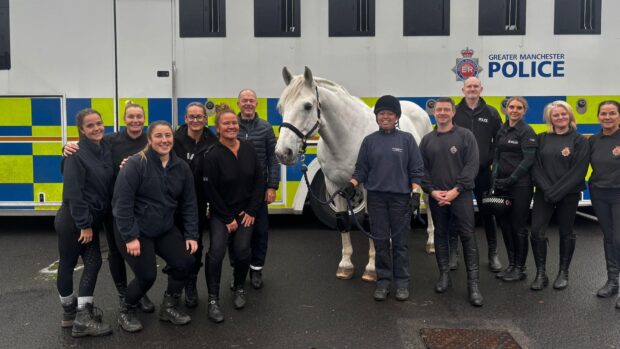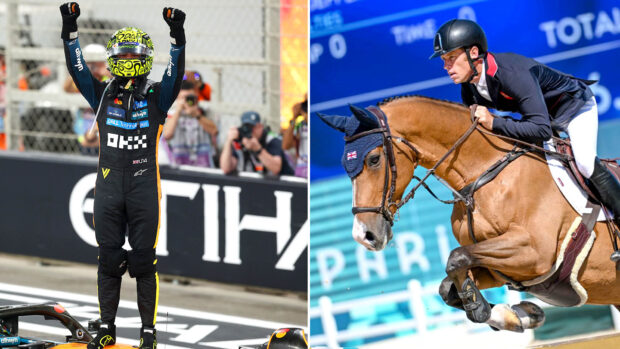Winter training for the first-ridden pony – and their rider – will pave the way to confidence in the ring come the summer shows. Learning to ride off the lead rein is arguably one of the biggest leaps a rider will make in their equestrian journey. This year, a new batch of mini showing stars will be making the transition from lead-rein jockeys to first-ridden riders, foraying from the safety and security of a handler by their side.
The choice of pony will be one of the most influential factors in determining how successful a child’s adjustment will be, but ensuring that the pair enters the ring with plenty of preparation under their belts will be equally important. Consistent flatwork training, repetition of the class structure and consideration of the overall picture should all be considered when preparing your first-ridden combination for the season ahead.
First-ridden classes can be found in most show schedules across all levels, and they’re among the most competitive showing classes as young riders’ talent in the saddle continues to advance. At major shows and on the county circuit, there are separate first-ridden classes for show ponies and for M&Ms. Show hunter types do not have a first-ridden class at major finals, but some shows do accommodate them.
At major and county shows, M&M and show ponies have separate first-ridden classes. Credit: Peter Nixon
Under British Show Pony Society (BSPS) rules, first-ridden show pony classes are open to riders who have not attained their 10th birthday before 1 January in the current year. M&M first-ridden ponies can be ridden by a rider who has not attained their 12th birthday before 1 January in the current year. No cantering is allowed on the go-round, only in the individual shows.
To provide younger jockeys with an initial experience of riding off the lead rein in the ring, some shows hold Tiny Tots sections. The Tiny Tots first-ridden class is open to riders who have not attained their eighth or ninth birthday (depending on whether it’s show pony or native classes) before 1 January in the current year. In the go-round, ponies will not be asked to change the rein. In their individual shows, ponies will be expected to walk up, trot back; cantering is optional, but no figure of eight or change of rein is required.
In the mini championships, first-ridden contenders will perform alongside the lead-rein combinations.
First-ridden pony training: 7 key lessons
H&H speaks to three of the circuit’s leading mini pony producers about training the first-ridden pony and child so that they are well-prepared for the upcoming show season.
{"content":"PGgzPjEuIFRoZSByaWdodCBwb255IGZvciB0aGUgam9iPC9oMz4KPHA+Rmlyc3QtcmlkZGVuIHNob3cgcG9uaWVzIGFyZSBzb21lIG9mIHRoZSBoYXJkZXN0IHRvIHNvdXJjZSBnaXZlbiB0aGUgbmVlZCBmb3IgdGhlbSB0byBiZSBxdWFsaXR5IGFuZCBzdXBlci1zYWZlIGluIGVxdWFsIG1lYXN1cmVzLiBTYXJhIFBhcnJvdHQgYW5kIGhlciBwYXJ0bmVyIENyYWlnIEVsZW5vciBydW4gQ3JhaWcgRWxlbm9yIEVxdWVzdHJpYW4sIGEgbGVhZGluZyBzaG93aW5nIHRlYW0gc3BlY2lhbGlzaW5nIGluIHByb2R1Y2luZyBwb25pZXMgZm9yIHRoZSBzaG93IHJpbmcuIFRoZXkgd2VyZSB0aGUgcHJvZHVjZXJzIG9mIHRoaXMgeWVhcuKAmXMgSE9ZUyBzdXByZW1lIHBvbnkgd2lubmVyLCB0aGUgbWluaSBzaG93IHBvbnkgY2hhbXBpb24gRGVydyBEcmVhbSBCb3kgYW5kIHRoZXkgaGF2ZSB0cmFpbmVkIG1hbnkgY2hhbXBpb24gZmlyc3QtcmlkZGVucyBvdmVyIHRoZSB5ZWFycy48L3A+Cgo8cD7igJxZb3UgY2FuIG9mdGVuIHRlbGwgaWYgYSBwb255IGhhcyB0aGUgcmlnaHQgdGVtcGVyYW1lbnQgdmVyeSBlYXJseSBvbizigJ0gU2FyYSBiZWdpbnMuIOKAnFVsdGltYXRlbHksIGlmIGEgcG9ueSBpcyByZWFsbHkgc2hhcnAgaXTigJlzIGxpa2VseSBnb2luZyB0byBiZSB1bnN1aXRhYmxlIGFuZCBpdCBuZWVkcyBhIGRpZmZlcmVudCBqb2IsIGV2ZW4gaWYgaXTigJlzIGJlYXV0aWZ1bC4gVGhlcmUgaXMgYSBsb3QgZm9yIHBvbmllcyB0byBkZWFsIHdpdGggYXQgdGhvc2UgYmlnZ2VyIHNob3dzLCBzbyB0aGV5IHJlYWxseSBuZWVkIHRvIGhhdmUgdGhlIGJyYWluIHRvIGNvcGUgd2l0aCB0aGUgYXRtb3NwaGVyZTsgdGhleSBuZWVkIHRvIGJlIHVuZmF6ZWQgYnkgbW9zdCB0aGluZ3MuPC9wPgo8cD7igJxPdXIgZmlyc3QtcmlkZGVuIHNob3cgcG9ueSBtYXJlIFNlYW1vb3IgTGFkeSBEZXJieSwgd2hvIHdvbiBhdCBIT1lTIGluIDIwMjIsIGlzIHRvdGFsbHkgdW5mbGFwcGFibGUgYW5kIGRvZXNu4oCZdCBjYXJlIGFib3V0IGFueXRoaW5nLiBXaGlsZSBzaGUgd2FzIHZlcnkgd2VsbCBzdGFydGVkIG9uIHRoZSBsZWFkLXJlaW4gYnkgT2xpdmVyIEJ1cmNoZWxsLCBzaGUga25vd3Mgc2hl4oCZcyBhIHF1ZWVuIGFuZCB0aGVyZWZvcmUgbmV2ZXIgZmVlbHMgdGhlIG5lZWQgdG8gc3Bvb2sgb3IgYmUgc2lsbHkuIFNoZSBkb2VzLCBob3dldmVyLCBoYXZlIGhlciBvd24gc2V0IG9mIHJ1bGVzIHdoaWNoIHdlIG11c3QgZm9sbG93LCBhbmQgd2UgZG8gcGxheSBieSB0aGVtIHRvIHRoZSBsZXR0ZXIuIEJ1dCBzaGUgdGhpbmtzIHNoZeKAmXMgdG9vIGltcG9ydGFudCB0byBiZSBib3RoZXJlZCBhYm91dCBhbnl0aGluZyBpbiB0aGUgcmluZyHigJ08L3A+CjxwPjxiciAvPgo8ZGl2IGlkPSJhdHRhY2htZW50Xzg4MjAyNSIgc3R5bGU9IndpZHRoOiAxNDEwcHgiIGNsYXNzPSJ3cC1jYXB0aW9uIGFsaWdubm9uZSI+PGltZyBmZXRjaHByaW9yaXR5PSJoaWdoIiBkZWNvZGluZz0iYXN5bmMiIGFyaWEtZGVzY3JpYmVkYnk9ImNhcHRpb24tYXR0YWNobWVudC04ODIwMjUiIGNsYXNzPSJsYXp5bG9hZCBibHVyLXVwIHNpemUtZnVsbCB3cC1pbWFnZS04ODIwMjUiIGRhdGEtcHJvY2Vzc2VkIHNyYz0iaHR0cHM6Ly9rZXlhc3NldHMudGltZWluY3VrLm5ldC9pbnNwaXJld3AvbGl2ZS93cC1jb250ZW50L3VwbG9hZHMvc2l0ZXMvMTQvMjAxNy8wMy9uZXctaGgtcGxhY2Vob2xkZXItMjAweDIwMC5wbmciIGRhdGEtc3JjPSJodHRwczovL2tleWFzc2V0cy50aW1laW5jdWsubmV0L2luc3BpcmV3cC9saXZlL3dwLWNvbnRlbnQvdXBsb2Fkcy9zaXRlcy8xNC8yMDI1LzAxL1NFQU1PT1ItTEFEWS1ERVJCWS5qcGciIGFsdD0iQSBjaGFtcGlvbiBzaG93IHBvbnksIGxlYWQtcmVpbiIgd2lkdGg9IjE0MDAiIGhlaWdodD0iNzg4IiBkYXRhLXNpemVzPSJhdXRvIiBkYXRhLXNyY3NldD0iaHR0cHM6Ly9rZXlhc3NldHMudGltZWluY3VrLm5ldC9pbnNwaXJld3AvbGl2ZS93cC1jb250ZW50L3VwbG9hZHMvc2l0ZXMvMTQvMjAyNS8wMS9TRUFNT09SLUxBRFktREVSQlkuanBnIDE0MDB3LCBodHRwczovL2tleWFzc2V0cy50aW1laW5jdWsubmV0L2luc3BpcmV3cC9saXZlL3dwLWNvbnRlbnQvdXBsb2Fkcy9zaXRlcy8xNC8yMDI1LzAxL1NFQU1PT1ItTEFEWS1ERVJCWS0zMDB4MTY5LmpwZyAzMDB3LCBodHRwczovL2tleWFzc2V0cy50aW1laW5jdWsubmV0L2luc3BpcmV3cC9saXZlL3dwLWNvbnRlbnQvdXBsb2Fkcy9zaXRlcy8xNC8yMDI1LzAxL1NFQU1PT1ItTEFEWS1ERVJCWS02MzB4MzU1LmpwZyA2MzB3LCBodHRwczovL2tleWFzc2V0cy50aW1laW5jdWsubmV0L2luc3BpcmV3cC9saXZlL3dwLWNvbnRlbnQvdXBsb2Fkcy9zaXRlcy8xNC8yMDI1LzAxL1NFQU1PT1ItTEFEWS1ERVJCWS0xMzV4NzYuanBnIDEzNXcsIGh0dHBzOi8va2V5YXNzZXRzLnRpbWVpbmN1ay5uZXQvaW5zcGlyZXdwL2xpdmUvd3AtY29udGVudC91cGxvYWRzL3NpdGVzLzE0LzIwMjUvMDEvU0VBTU9PUi1MQURZLURFUkJZLTMyMHgxODAuanBnIDMyMHcsIGh0dHBzOi8va2V5YXNzZXRzLnRpbWVpbmN1ay5uZXQvaW5zcGlyZXdwL2xpdmUvd3AtY29udGVudC91cGxvYWRzL3NpdGVzLzE0LzIwMjUvMDEvU0VBTU9PUi1MQURZLURFUkJZLTYyMHgzNDkuanBnIDYyMHcsIGh0dHBzOi8va2V5YXNzZXRzLnRpbWVpbmN1ay5uZXQvaW5zcGlyZXdwL2xpdmUvd3AtY29udGVudC91cGxvYWRzL3NpdGVzLzE0LzIwMjUvMDEvU0VBTU9PUi1MQURZLURFUkJZLTkyMHg1MTguanBnIDkyMHcsIGh0dHBzOi8va2V5YXNzZXRzLnRpbWVpbmN1ay5uZXQvaW5zcGlyZXdwL2xpdmUvd3AtY29udGVudC91cGxvYWRzL3NpdGVzLzE0LzIwMjUvMDEvU0VBTU9PUi1MQURZLURFUkJZLTEyMjB4Njg3LmpwZyAxMjIwdyIgc2l6ZXM9IihtYXgtd2lkdGg6IDE0MDBweCkgMTAwdncsIDE0MDBweCIgLz48cCBpZD0iY2FwdGlvbi1hdHRhY2htZW50LTg4MjAyNSIgY2xhc3M9IndwLWNhcHRpb24tdGV4dCI+U2hvdyBwb255IFNlYW1vb3IgTGFkeSBEZXJieSB3YXMgc3RhcnRlZCBvbiB0aGUgbGVhZC1yZWluIGJ5IE9saXZlciBCdXJjaGVsbCwgYnV0IGhhcyBwcm92ZWQgZXF1YWxseSBhZGVwdCBhcyBhIGZpcnN0LXJpZGRlbiwgcHJvZHVjZWQgYnkgU2FyYSBQYXJyb3R0LiBDcmVkaXQ6IEFudGhvbnkgUmV5bm9sZHM8L3A+PC9kaXY+PC9wPgo8cD5TaGFybiBMaW5uZXkgaXMgYSBsZWFkaW5nIG1pbmkgcG9ueSBwcm9kdWNlciB3aG8gaGFzIGxlZCBhbmQgcHJvZHVjZWQgSE9ZUyBhbmQgUklIUyBjaGFtcGlvbnMuIEluIDIwMjQsIFNoYXJuIHdhcyByZXNwb25zaWJsZSBmb3IgcHJvZHVjaW5nIHRoZSBSSUhTIE0mYW1wO00gbWluaSBIZXJpdGFnZSBjaGFtcGlvbiBUaGlzdGxlZG93biBQcmluY2VzcyBMZXRpemlhLiBTaGFybiBhZ3JlZXMgdGhhdCBpZiB0aGUgcG9ueSBoYXMgYSBjYW4tZG8gYXR0aXR1ZGUsIGl0IGhhcyBzdHJvbmcgcG90ZW50aWFsIGFzIGEgZmlyc3QtcmlkZGVuIG1vdW50LjwvcD4KPHA+4oCcSWYgYSBwb255IGlzIHNhbmUgYW5kIGlzbuKAmXQgdG9vIHNoYXJwLCBuaW5lIHRpbWVzIG91dCBvZiAxMCB0aGV5IGNhbiBiZSB0YXVnaHQgdGhlIGpvYizigJ0gU2hhcm4gc2F5cy4g4oCcVGhlIG1haW4gdGhpbmdzIEkgd291bGQgbG9vayBmb3IgaXMgZW5zdXJpbmcgYSBwb255IGlzbuKAmXQgdG9vIGhlYWRzdHJvbmcgb3Igc2hhcnAsIGJ1dCBvdGhlcndpc2UgbW9zdCBwb25pZXMgY2FuIG1ha2UgZ3JlYXQgZmlyc3QtcmlkZGVucywgZXZlbiBpZiB0aGV54oCZdmUgaGFkIG90aGVyIGpvYnMgcHJldmlvdXNseS4gVGhlIHNob3cgcG9ueSBIb2xseWJ1c2ggRW5jaGFudG1lbnQgZ2F2ZSBtZSB0aGUgZmlyc3QgSE9ZUyB3aW4gb2YgbXkgY2FyZWVyIGFzIGEgbGVhZC1yZWluLCBidXQgc2hlIGxhdGVyIHdlbnQgb250byBiZSBzdWNjZXNzZnVsIGZpcnN0LXJpZGRlbiwgZXZlbiBmaW5pc2hpbmcgc2Vjb25kIGF0IEhPWVMu4oCdPC9wPgo8ZGl2IGlkPSJhdHRhY2htZW50Xzg4MjAyNCIgc3R5bGU9IndpZHRoOiAxNDEwcHgiIGNsYXNzPSJ3cC1jYXB0aW9uIGFsaWdubm9uZSI+PGltZyBkZWNvZGluZz0iYXN5bmMiIGFyaWEtZGVzY3JpYmVkYnk9ImNhcHRpb24tYXR0YWNobWVudC04ODIwMjQiIGNsYXNzPSJsYXp5bG9hZCBibHVyLXVwIHdwLWltYWdlLTg4MjAyNCBzaXplLWZ1bGwiIGRhdGEtcHJvY2Vzc2VkIHNyYz0iaHR0cHM6Ly9rZXlhc3NldHMudGltZWluY3VrLm5ldC9pbnNwaXJld3AvbGl2ZS93cC1jb250ZW50L3VwbG9hZHMvc2l0ZXMvMTQvMjAxNy8wMy9uZXctaGgtcGxhY2Vob2xkZXItMjAweDIwMC5wbmciIGRhdGEtc3JjPSJodHRwczovL2tleWFzc2V0cy50aW1laW5jdWsubmV0L2luc3BpcmV3cC9saXZlL3dwLWNvbnRlbnQvdXBsb2Fkcy9zaXRlcy8xNC8yMDI1LzAxL0hvbGx5YnVzaC1FbmNoYW50bWVudC1TMzdfMDE2Nl8xMzk1NDk0NDJfMjI5OTg2MjkxLmpwZyIgYWx0PSJMZWFkLXJlaW4gcG9ueSBIb2xseWJ1c2ggRW5jaGFudG1lbnQ6IHRoZSB0cmFuc2l0aW9uIHRvIGZpcnN0LXJpZGRlbiBwb255IHJlcXVpcmVzIHBsZW50eSBvZiB0cmFpbmluZyIgd2lkdGg9IjE0MDAiIGhlaWdodD0iNzg4IiBkYXRhLXNpemVzPSJhdXRvIiBkYXRhLXNyY3NldD0iaHR0cHM6Ly9rZXlhc3NldHMudGltZWluY3VrLm5ldC9pbnNwaXJld3AvbGl2ZS93cC1jb250ZW50L3VwbG9hZHMvc2l0ZXMvMTQvMjAyNS8wMS9Ib2xseWJ1c2gtRW5jaGFudG1lbnQtUzM3XzAxNjZfMTM5NTQ5NDQyXzIyOTk4NjI5MS5qcGcgMTQwMHcsIGh0dHBzOi8va2V5YXNzZXRzLnRpbWVpbmN1ay5uZXQvaW5zcGlyZXdwL2xpdmUvd3AtY29udGVudC91cGxvYWRzL3NpdGVzLzE0LzIwMjUvMDEvSG9sbHlidXNoLUVuY2hhbnRtZW50LVMzN18wMTY2XzEzOTU0OTQ0Ml8yMjk5ODYyOTEtMzAweDE2OS5qcGcgMzAwdywgaHR0cHM6Ly9rZXlhc3NldHMudGltZWluY3VrLm5ldC9pbnNwaXJld3AvbGl2ZS93cC1jb250ZW50L3VwbG9hZHMvc2l0ZXMvMTQvMjAyNS8wMS9Ib2xseWJ1c2gtRW5jaGFudG1lbnQtUzM3XzAxNjZfMTM5NTQ5NDQyXzIyOTk4NjI5MS02MzB4MzU1LmpwZyA2MzB3LCBodHRwczovL2tleWFzc2V0cy50aW1laW5jdWsubmV0L2luc3BpcmV3cC9saXZlL3dwLWNvbnRlbnQvdXBsb2Fkcy9zaXRlcy8xNC8yMDI1LzAxL0hvbGx5YnVzaC1FbmNoYW50bWVudC1TMzdfMDE2Nl8xMzk1NDk0NDJfMjI5OTg2MjkxLTEzNXg3Ni5qcGcgMTM1dywgaHR0cHM6Ly9rZXlhc3NldHMudGltZWluY3VrLm5ldC9pbnNwaXJld3AvbGl2ZS93cC1jb250ZW50L3VwbG9hZHMvc2l0ZXMvMTQvMjAyNS8wMS9Ib2xseWJ1c2gtRW5jaGFudG1lbnQtUzM3XzAxNjZfMTM5NTQ5NDQyXzIyOTk4NjI5MS0zMjB4MTgwLmpwZyAzMjB3LCBodHRwczovL2tleWFzc2V0cy50aW1laW5jdWsubmV0L2luc3BpcmV3cC9saXZlL3dwLWNvbnRlbnQvdXBsb2Fkcy9zaXRlcy8xNC8yMDI1LzAxL0hvbGx5YnVzaC1FbmNoYW50bWVudC1TMzdfMDE2Nl8xMzk1NDk0NDJfMjI5OTg2MjkxLTYyMHgzNDkuanBnIDYyMHcsIGh0dHBzOi8va2V5YXNzZXRzLnRpbWVpbmN1ay5uZXQvaW5zcGlyZXdwL2xpdmUvd3AtY29udGVudC91cGxvYWRzL3NpdGVzLzE0LzIwMjUvMDEvSG9sbHlidXNoLUVuY2hhbnRtZW50LVMzN18wMTY2XzEzOTU0OTQ0Ml8yMjk5ODYyOTEtOTIweDUxOC5qcGcgOTIwdywgaHR0cHM6Ly9rZXlhc3NldHMudGltZWluY3VrLm5ldC9pbnNwaXJld3AvbGl2ZS93cC1jb250ZW50L3VwbG9hZHMvc2l0ZXMvMTQvMjAyNS8wMS9Ib2xseWJ1c2gtRW5jaGFudG1lbnQtUzM3XzAxNjZfMTM5NTQ5NDQyXzIyOTk4NjI5MS0xMjIweDY4Ny5qcGcgMTIyMHciIHNpemVzPSIobWF4LXdpZHRoOiAxNDAwcHgpIDEwMHZ3LCAxNDAwcHgiIC8+PHAgaWQ9ImNhcHRpb24tYXR0YWNobWVudC04ODIwMjQiIGNsYXNzPSJ3cC1jYXB0aW9uLXRleHQiPuKAnE1vc3QgcG9uaWVzIGNhbiBtYWtlIGdyZWF0IGZpcnN0LXJpZGRlbnMs4oCdIHNheXMgU2hhcm4gTGlubmV5LCBnaXZpbmcgdGhlIGV4YW1wbGUgb2YgSG9sbHlidXNoIEVuY2hhbnRtZW50LCBhIEhPWVMgd2lubmVyIG9uIHRoZSBsZWFkLXJlaW4gYW5kIHJlc2VydmUgYXMgYSBmaXJzdC1yaWRkZW4uIENyZWRpdDogU3RldmUgRGF3ZTwvcD48L2Rpdj4KPGgzPjIuIE92ZXJjb21wbGljYXRpbmcgdGhlIHByb2Nlc3M8L2gzPgo8cD5XaXRoIHRoZSBzaG93IHNlYXNvbiBhcHByb2FjaGluZywgaXQgbWlnaHQgYmUgdGVtcHRpbmcgaW4geW91ciBmaXJzdC1yaWRkZW4gcG9ueSB0cmFpbmluZyBzZXNzaW9ucyB0byBwdXNoIHlvdXIgbWluaSByaWRlciB0byB0aGUgbWF4aW11bSB0byB0cnkgYW5kIHBlcmZlY3QgZXZlcnl0aGluZyBiZWZvcmUgdGhlaXIgZmlyc3Qgc2hvdyByaW5nIG91dGluZy4gVGhpcyBpcyBhIG1pc3Rha2UsIGFzIFNhcmEgZXhwbGFpbnMuPC9wPgo8cD7igJxTbyBtYW55IHBlb3BsZSBvdmVyY29tcGxpY2F0ZSB0aGUgcHJvY2VzcyBhbmQgdGhpcyBpcyB3aGVyZSB0aGUgcHJvYmxlbXMgY29tZTsgdGhleSB0cnkgdG8gZ2V0IHRoZSBuZXcgZmlyc3QtcmlkZGVuIGpvY2tleSB0byBkbyB0b28gbWFueSB0aGluZ3MgYXQgb25jZSzigJ0gc2hlIHNheXMuIOKAnEkgYWx3YXlzIHRlYWNoIHRocmVlIHRoaW5ncyBpbml0aWFsbHkg4oCTIGdvIHN0cmFpZ2h0LCBnbyBhdCBhIOKAmHNwZWVkIG9mIGZpdmXigJksIGFuZCB1c2UgYWxsIG9mIHlvdXIgcmluZy4gSW4gdGVybXMgb2Ygc3RyYWlnaHRuZXNzLCBJIHRlbGwgdGhlIGNoaWxkIHRvIHRoaW5rIG9mIGEgc3RyYWlnaHQgbGluZSB0aHJvdWdoIHRoZSDigJhlYXJzIGFuZCBzaG91bGRlcnMgdG8gdGhlIHRhaWzigJkuPC9wPgo8cD7igJxUbyBiZWdpbiB0byB3b3JrIGluIGEgY29uc2lzdGVudCByaHl0aG0gYW5kIHNwZWVkLCBpZiB5b3UgdGVsbCB0aGUgY2hpbGQgdG8gdGhpbmsgdGhhdCBvbmUgaXMgc2xvdywgYW5kIDEwIGlzIGZhc3QsIHRoZXkgY29uc2lkZXIgZml2ZSBhcyBtaWRkbGUgc3BlZWQsIHdoaWNoIGlzIGFib3V0IHJpZ2h0IGZvciBhIGZpcnN0LXJpZGRlbiBjbGFzcy48L3A+CjxwPuKAnFRoZW4sIGlmIHRoZXkgdXNlIGFsbCBvZiB0aGUgcmluZywgZXZlbiB3aGVuIHRoZXkgZ28gd3JvbmcgaW4gdGhlaXIgc2hvdyB0aGV5IGNhbiB1c3VhbGx5IHB1bGwgc29tZXRoaW5nIHRvZ2V0aGVyIGFzIHRoZXnigJl2ZSBnb3QgZW5vdWdoIHNwYWNlLiBHaXZpbmcgbW9yZSB0aGFuIHRocmVlIGFpbXMgYXQgb25jZSBjYW4gb3ZlcndoZWxtIGEgeW91bmcgcmlkZXIuIE9uY2UgdGhlc2UgYmFzaWNzIGFyZSBpbiBwbGFjZSwgeW91IGNhbiBmaW5lLXR1bmUgdGhlIHJlc3Qu4oCdPC9wPgo8cD5TYXJhaCBOZXdib3VsZCAobsOpZSBFbW1lcnNvbikgaXMgb25lIG9mIHRoZSBjaXJjdWl04oCZcyBtb3N0IGNvbnNpc3RlbnQgbWluaSBwb255IHByb2R1Y2Vycy4gU2FyYWggYW5kIGhlciBmYXRoZXIgUGV0ZXIgaGF2ZSBwcm9kdWNlZCBtYW55IEhPWVMgYW5kIFJJSFMgd2lubmVycyBhbmQgdGhleSBhbHNvIHJ1biBhIHBvcHVsYXIgcmlkaW5nIHNjaG9vbC4gU2FyYWggcmVjb21tZW5kcyB0aGF0LCBpZiBwb3NzaWJsZSwgYSBjaGlsZCBjYW4gYmVuZWZpdCBmcm9tIGhhdmluZyBhIGZ1biBwb255IHRvIHJpZGUgb2ZmIHRoZSBsZWFkIHJlaW4gYmVmb3JlIHRoZSBtb3ZlIG9udG8gdGhlaXIgY29tcGV0aXRpdmUgZmlyc3QtcmlkZGVuIHJpZGUgc28gdGhleSBjYW4gZmluZCB0aGVpciBiYWxhbmNlIGFuZCByZWZpbmUgdGhlaXIgdGVjaG5pcXVlLjwvcD4KPHA+4oCcTXkgY2hpbGRyZW4gcmlkZSB0aGUgcmlkaW5nIHNjaG9vbCBwb25pZXMgYSBsb3QgYW5kIGl0IG1lYW5zIHRoZXkgY2FuIGxlYXJuIHRoZSByb3BlcyB3aXRob3V0IHRoZSBwcmVzc3VyZSzigJ0gU2FyYWggc2F5cy4g4oCcT2YgY291cnNlLCBub3QgZXZlcnlvbmUgaGFzIHRoaXMgbHV4dXJ5LCBidXQgaWYgdGhleSBjYW4gcmlkZSBzb21ldGhpbmcgZWxzZSBhbG9uZ3NpZGUgdGhlaXIgYmVhdXRpZnVsIGZpcnN0LXJpZGRlbiBwb255IHRoZXkgY2FuIHJlYWxseSBiZW5lZml0LuKAnTwvcD4KPGgzPjMuIFNhdC1uYXYgZXJyb3JzPC9oMz4KPHA+4oCcTW9zdCBvZiBvdXIgdGltZSBpbiB3aW50ZXIgaXMgc3BlbnQgbGVhcm5pbmcgYW5kIHByYWN0aXNpbmcgc2hvd3Ms4oCdIHNheXMgU2FyYWggb2YgZmlyc3QtcmlkZGVuIHBvbnkgdHJhaW5pbmcuIOKAnEFuZCB3ZSB0ZWFjaCB0aGUgc2hvd3MgaW4gdHJvdCBpbml0aWFsbHkgYmVmb3JlIHdlIGV2ZW4gY29uc2lkZXIgYWRkaW5nIGNhbnRlci4gV2UgaGF2ZSB0d28gc2hvd3MgZm9yIG91ciBqb2NrZXlzIHRvIGxlYXJuIOKAkyBTYXJhaOKAmXMgc2hvdyBhbmQgUGV0ZXLigJlzIHNob3cuIE9uZSBzaG93IGlzIGdvaW5nIHRvd2FyZHMgdGhlIGxpbmUtdXAgYW5kIHRoZSBvdGhlciBhd2F5IGZyb20gaXQuIFRoZW4sIHdoZW4gd2XigJlyZSBhdCBhIHNob3cgd2UgY2FuIHRlbGwgdGhlIGNoaWxkcmVuIHRvIHJpZGUgZWl0aGVyIFNhcmFoIG9yIFBldGVy4oCZcyBzaG93IGRlcGVuZGluZyBvbiB3aGVyZSB0aGUgbGluZS11cCBpcy48L3A+CjxwPuKAnFdlIGFsc28gZ2V0IHRoZSBwYXJlbnRzIHRvIHZpZGVvIHRoZWlyIHNob3dzIGluIHRyYWluaW5nIHNvIHRoZSBjaGlsZHJlbiBjYW4gZ28gaG9tZSBhbmQgcHJhY3Rpc2Ugb24gZm9vdCBpbiB0aGUga2l0Y2hlbiBvciBnYXJkZW4g4oCTIGl0IHJlYWxseSBoZWxwcyHigJ08L3A+CjxoMz40LiBTdGF5aW5nIGNvbnNpc3RlbnQ8L2gzPgo8cD5Fc3RhYmxpc2hpbmcgY29uc2lzdGVuY3kgaW4gc3BlZWQgYW5kIHJoeXRobSBjYW4gYmUgdHJpY2t5IGZvciB5b3VuZyByaWRlcnMgdG8gZ3Jhc3Agd2hlbiB0aGV5IGZpcnN0IGZseSBzb2xvLCB0aG91Z2gga2VlcGluZyB0aGVtIG9uIHRoZSBiYWxsIGluIHRyYWluaW5nIHdpbGwgZXZlbnR1YWxseSBmb2xsb3cgdGhyb3VnaCBpbnRvIHRoZSByaW5nLjwvcD4KPHA+4oCcRHVyaW5nIGxlc3NvbnMsIEkgd2lsbCBnZXQgdGhlIGpvY2tleXMgdG8gcmlkZSBsb2FkcyBvZiBjaXJjbGVzLCBjaGFuZ2VzIG9mIHJlaW4sIGZpZ3VyZXMgb2YgZWlnaHRzLCBhbmQgSeKAmWxsIGFsc28gZ2V0IHRoZW0gdG8gcmlkZSBvZmYgdGhlIHRyYWNrLCByYXRoZXIgdGhhbiBqdXN0IHN0YXlpbmcgb24gdGhlIGVkZ2Ugb2YgdGhlIGFyZW5hLOKAnSBTaGFybiBzYXlzLiDigJxJdCBzb3VuZHMgc2ltcGxlIGJ1dCBnZXR0aW5nIHRoZW0gdG8gY2hhbmdlIGRpcmVjdGlvbiBoZWxwcyB0aGUgcGFjZSBiZWNvbWUgbW9yZSBjb25zaXN0ZW50IGFzIHRoZXnigJlyZSBjb25zdGFudGx5IGhhdmluZyB0byB0aGluayBhYm91dCB0aGVpciByaWRpbmcu4oCdPC9wPgo8aDM+NS4gV29ya2luZyBpbiBhIGNvbnRhY3QsIHdoaWxlIHN0YXlpbmcgbGlnaHQ8L2gzPgo8cD7igJxUaGUgbWFpbiB0aGluZyBpcyB0byBnZXQgdGhlIHJpZGVyIHRvIGVzdGFibGlzaCBob3cgdG8gZ28gc3RyYWlnaHQgYW5kIHRvIGdvIGZvcndhcmRzLOKAnSBTYXJhIHNheXMuIOKAnFRoZW4sIHlvdSBjYW4gYXNrIHRoZW0gdG8gdGFrZSBhIGxpdHRsZSBiaXQgbW9yZSBjb250YWN0IGRvd24gdGhlIHJlaW4uIEkgdXN1YWxseSBmaW5kIHRoYXQgYXNraW5nIHRoZSByaWRlciBpZiB0aGV5IGNhbiBmZWVsIHRoZSBzYW1lIGRvd24gZWFjaCByZWluIGlzIGEgZ29vZCB3YXkgdG8gd29yayBvbiBzdHJhaWdodG5lc3MuIElmIHRoZXkgcmlkZSBhdCB0aGF0IHNwZWVkIG9mIGZpdmUgd2hpbGUga2VlcGluZyB0aGUgc2FtZSBmZWVsIGRvd24gZWFjaCByZWluLCB0aGV5IGJlZ2luIHRvIHVuZGVyc3RhbmQgaG93IHRvIHJpZGUgaW50byB0aGUgY29udGFjdC48L3A+CjxwPuKAnFdoZW4gdGhpcyBpcyBzb2xpZCwgSSB3b3VsZCBzbG93bHkgYWRkIGluIHRyYW5zaXRpb25zLCB3aGlsZSBhZ2FpbiBlbmNvdXJhZ2luZyB0aGUgY2hpbGQgdG8ga2VlcCB0aGUgcmVpbiBjb250YWN0IHRoZSBzYW1lIGRvd24gZWFjaCByZWluLiBJZiB5b3UgY2FuIG5haWwgdGhlIHJoeXRobSBhbmQgc3RyYWlnaHRuZXNzLCB5b3UgY2FuIGFkZCB0aGUgcmVzdCBvbiBlYXNpbHku4oCdPC9wPgo8ZGl2IGlkPSJhdHRhY2htZW50Xzg4MjA1NyIgc3R5bGU9IndpZHRoOiAxNDEwcHgiIGNsYXNzPSJ3cC1jYXB0aW9uIGFsaWdubm9uZSI+PGltZyBkZWNvZGluZz0iYXN5bmMiIGFyaWEtZGVzY3JpYmVkYnk9ImNhcHRpb24tYXR0YWNobWVudC04ODIwNTciIGNsYXNzPSJsYXp5bG9hZCBibHVyLXVwIHNpemUtZnVsbCB3cC1pbWFnZS04ODIwNTciIGRhdGEtcHJvY2Vzc2VkIHNyYz0iaHR0cHM6Ly9rZXlhc3NldHMudGltZWluY3VrLm5ldC9pbnNwaXJld3AvbGl2ZS93cC1jb250ZW50L3VwbG9hZHMvc2l0ZXMvMTQvMjAxNy8wMy9uZXctaGgtcGxhY2Vob2xkZXItMjAweDIwMC5wbmciIGRhdGEtc3JjPSJodHRwczovL2tleWFzc2V0cy50aW1laW5jdWsubmV0L2luc3BpcmV3cC9saXZlL3dwLWNvbnRlbnQvdXBsb2Fkcy9zaXRlcy8xNC8yMDI1LzAxL0JTUFMtTWlkU3VtbWVyLVNob3ctMjIuMDYuMTkxMDI1NV8zMTg2OTQ5NDFfNTE1NDg3MDcyLmpwZyIgYWx0PSJBIGZpcnN0LXJpZGRlbiBwb255IHNob3dpbmcgdGhlIGJlbmVmaXRzIG9mIHRyYWluaW5nIHdpdGggYSBsaWdodCBhbmQgY29uc2lzdGVudCBjb250YWN0IiB3aWR0aD0iMTQwMCIgaGVpZ2h0PSI5MDAiIGRhdGEtc2l6ZXM9ImF1dG8iIGRhdGEtc3Jjc2V0PSJodHRwczovL2tleWFzc2V0cy50aW1laW5jdWsubmV0L2luc3BpcmV3cC9saXZlL3dwLWNvbnRlbnQvdXBsb2Fkcy9zaXRlcy8xNC8yMDI1LzAxL0JTUFMtTWlkU3VtbWVyLVNob3ctMjIuMDYuMTkxMDI1NV8zMTg2OTQ5NDFfNTE1NDg3MDcyLmpwZyAxNDAwdywgaHR0cHM6Ly9rZXlhc3NldHMudGltZWluY3VrLm5ldC9pbnNwaXJld3AvbGl2ZS93cC1jb250ZW50L3VwbG9hZHMvc2l0ZXMvMTQvMjAyNS8wMS9CU1BTLU1pZFN1bW1lci1TaG93LTIyLjA2LjE5MTAyNTVfMzE4Njk0OTQxXzUxNTQ4NzA3Mi0zMDB4MTkzLmpwZyAzMDB3LCBodHRwczovL2tleWFzc2V0cy50aW1laW5jdWsubmV0L2luc3BpcmV3cC9saXZlL3dwLWNvbnRlbnQvdXBsb2Fkcy9zaXRlcy8xNC8yMDI1LzAxL0JTUFMtTWlkU3VtbWVyLVNob3ctMjIuMDYuMTkxMDI1NV8zMTg2OTQ5NDFfNTE1NDg3MDcyLTYyMng0MDAuanBnIDYyMncsIGh0dHBzOi8va2V5YXNzZXRzLnRpbWVpbmN1ay5uZXQvaW5zcGlyZXdwL2xpdmUvd3AtY29udGVudC91cGxvYWRzL3NpdGVzLzE0LzIwMjUvMDEvQlNQUy1NaWRTdW1tZXItU2hvdy0yMi4wNi4xOTEwMjU1XzMxODY5NDk0MV81MTU0ODcwNzItMTM1eDg3LmpwZyAxMzV3LCBodHRwczovL2tleWFzc2V0cy50aW1laW5jdWsubmV0L2luc3BpcmV3cC9saXZlL3dwLWNvbnRlbnQvdXBsb2Fkcy9zaXRlcy8xNC8yMDI1LzAxL0JTUFMtTWlkU3VtbWVyLVNob3ctMjIuMDYuMTkxMDI1NV8zMTg2OTQ5NDFfNTE1NDg3MDcyLTMyMHgyMDYuanBnIDMyMHcsIGh0dHBzOi8va2V5YXNzZXRzLnRpbWVpbmN1ay5uZXQvaW5zcGlyZXdwL2xpdmUvd3AtY29udGVudC91cGxvYWRzL3NpdGVzLzE0LzIwMjUvMDEvQlNQUy1NaWRTdW1tZXItU2hvdy0yMi4wNi4xOTEwMjU1XzMxODY5NDk0MV81MTU0ODcwNzItNjIweDM5OS5qcGcgNjIwdywgaHR0cHM6Ly9rZXlhc3NldHMudGltZWluY3VrLm5ldC9pbnNwaXJld3AvbGl2ZS93cC1jb250ZW50L3VwbG9hZHMvc2l0ZXMvMTQvMjAyNS8wMS9CU1BTLU1pZFN1bW1lci1TaG93LTIyLjA2LjE5MTAyNTVfMzE4Njk0OTQxXzUxNTQ4NzA3Mi05MjB4NTkxLmpwZyA5MjB3LCBodHRwczovL2tleWFzc2V0cy50aW1laW5jdWsubmV0L2luc3BpcmV3cC9saXZlL3dwLWNvbnRlbnQvdXBsb2Fkcy9zaXRlcy8xNC8yMDI1LzAxL0JTUFMtTWlkU3VtbWVyLVNob3ctMjIuMDYuMTkxMDI1NV8zMTg2OTQ5NDFfNTE1NDg3MDcyLTEyMjB4Nzg0LmpwZyAxMjIwdyIgc2l6ZXM9IihtYXgtd2lkdGg6IDE0MDBweCkgMTAwdncsIDE0MDBweCIgLz48cCBpZD0iY2FwdGlvbi1hdHRhY2htZW50LTg4MjA1NyIgY2xhc3M9IndwLWNhcHRpb24tdGV4dCI+QSBmaXJzdC1yaWRkZW4gcG9ueSBjaGFtcGlvbiBsaXN0ZW5pbmcgdG8gdGhlaXIgcmlkZXIuIENyZWRpdDogVHJldm9yIE1lZWtzPC9wPjwvZGl2Pgo8aDM+Ni4gQ29waW5nIHdpdGggbmVydmVzPC9oMz4KPHA+4oCcSXTigJlzIHNvIGltcG9ydGFudCB0byBtYWtlIHN1cmUgdGhlIGpvY2tleSBpcyBoYXBweSBhbmQgdGhhdCB0aGV5IGRvbuKAmXQgaGF2ZSB0b28gbXVjaCBwcmVzc3VyZSBvbiB0aGVtIHdoZW4gdGhleSBmaXJzdCBzdGFydCBvdXQg4oCTIHRoZXnigJl2ZSBnb3QgdG8gZW5qb3kgaXQs4oCdIFNoYXJuIHNheXMuIOKAnFByb2JsZW1zIGFyZSBnb2luZyB0byBjcm9wIHVwIG9uIHRob3NlIGZpcnN0IGZldyBvdXRpbmdzLCBlc3BlY2lhbGx5IHNhdC1uYXYgaXNzdWVzLCBhbmQgaXTigJlzIG5vdCBnb2luZyB0byBiZSBwZXJmZWN0IHN0cmFpZ2h0IGF3YXkuIEdpdmUgeW91cnNlbGYgdGhvc2UgZmlyc3Qgc2hvd3MgdG8gbWFrZSBtaXN0YWtlcyBhbmQgZW5zdXJlIHRoZSBjb21iaW5hdGlvbiBnZXRzIGEgcG9zaXRpdmUgc3RhcnQgdG8gdGhlaXIgcGFydG5lcnNoaXAuPC9wPgo8cD7igJxQcmFjdGljZSBtYWtlcyBwZXJmZWN0LCBzbyBldmVuIGJlZm9yZSB5b3UgZ28gb3V0IHNob3dpbmcsIGdldCB0aGUgcGFpciBvdXQgb2YgdGhlaXIgb3JpZ2luYWwgZW52aXJvbm1lbnQgYXQgYXJlbmEgaGlyZXMgYW5kIHRvIGNsaW5pY3Mu4oCdPC9wPgo8aDM+Ny4gRmluZGluZyB0aGUgYnJha2VzPC9oMz4KPHA+U2FyYWggZmluZHMgdGhhdCB3aGVuIGEgY2hpbGQgaGFzIGJlZW4gb24gdGhlIGxlYWQtcmVpbiBmb3Igc28gbG9uZyBvciBoYXZlIGJlY29tZSBhY2N1c3RvbWVkIHRvIHJpZGluZyBxdWlldCBwb25pZXMsIHRoZXkgY2FuIHN0cnVnZ2xlIHRvIG1vdmUgb24gdG8gdGhlIG1vcmUgcmVmaW5lZCBwb255IGVhcm1hcmtlZCBmb3IgdGhlIHNob3cgcmluZy4gVHJhaW5pbmcgdGhlbSB0byByaWRlIGEgZmlyc3QtcmlkZGVuIHBvbnkgd2lsbCByZXF1aXJlIHBsZW50eSBvZiB3b3JrIG9uIHRoZWlyIHNlYXQgc2VjdXJpdHkgYW5kIHBvc2l0aW9uLjwvcD4KPHA+4oCcT2Z0ZW4sIGEgY2hpbGQgd2lsbCBoYXZlIG9ubHkgcmlkZGVuIGEgcG9ueSB3aG8gaXMgc3VwZXIgcXVpZXQgYW5kIG5lZWQga2lja2luZyBhbG9uZyzigJ0gU2FyYWggc2F5cy4g4oCcU29tZSBvZiB0aGVzZSBnb29kIGZpcnN0LXJpZGRlbnMgYXJlIGxpa2UgbGl0dGxlIEZlcnJhcmlzIGFuZCBjb25zZXF1ZW50bHkgdGhlIGNoaWxkIGRvZXNu4oCZdCBrbm93IHdoZXJlIHRoZSBicmFrZXMgYXJlIGFuZCB0aGV5IGNhbiYjODIxNzt0IHN0b3AgdGhlbS4gUGx1cywgZWFybHkgb24sIGEgY2hpbGQgaXMgdW5saWtlbHkgdG8gaGF2ZSBhIHZlcnkgc3Ryb25nIHNlYXQgYW5kIHRoZXkgdGVuZCB0byBwZXJjaCBvbiB0aGUgcG9ueSwgd2hpY2ggYWxzbyBtYWtlcyBpdCBoYXJkZXIgZm9yIHRoZW0gdG8gc3RvcC48L3A+CjxwPuKAnERhZCB3aWxsIHdvcmsgb24gZ2V0dGluZyB0aGUgY2hpbGRyZW4gc2VjdXJlIGluIHRoZSBzYWRkbGUgd2hpbGUgdGhleeKAmXJlIHN0YW5kaW5nIHN0aWxsIG9uIHRoZWlyIHBvbmllcywgdGVhY2hpbmcgdGhlbSB0byBrZWVwIHRoZWlyIGhlZWxzIGRvd24gYW5kIGZlZWwgZG93biB0aGUgcmVpbiB3aGlsZSBzaXR0aW5nIGRvd24gYW5kIGJhY2suIFdoaWxlIEnigJltIHRlYWNoaW5nLCBJIHdpbGwgZ2V0IHRoZSBjaGlsZHJlbiB0cm90dGluZyBhcm91bmQgYmVmb3JlIHN1ZGRlbmx5IGFza2luZyB0aGVtIHRvIHN0b3AuIFRoZXkgbXVzdCBsZWFybiB0byBzaXQgYmFjayBhbmQgdXNlIHRoZWlyIHNlYXQgdG8gc3RvcC4gSXTigJlzIHNvIGltcG9ydGFudCB0aGV5IGNhbiBwdWxsIHVwOyBJ4oCZdmUgc2VlbiBzbyBtYW55IHBvbmllcyBkbyB0aGUgd2FsbCBvZiBkZWF0aCBhcm91bmQgdGhlIHNjaG9vbCBhbmQgaXTigJlzIGZyaWdodGVuaW5nLuKAnTwvcD4KPGRpdiBjbGFzcz0iaW5qZWN0aW9uIj48L2Rpdj4KPHA+PGVtPlRoYW5rIHlvdSBmb3Igc3Vic2NyaWJpbmcgdG8gdGhlIEgmYW1wO0ggd2Vic2l0ZS4gV2Ugd2lsbCBiZSBicmluZ2luZyB5b3Ugc2hvd2luZyBuZXdzIGZyb20gbWFqb3IgZGF0ZXMgb24gdGhlIGNpcmN1aXQgaW5jbHVkaW5nIFJveWFsIFdpbmRzb3IsIFJveWFsIFdlbHNoLCBSb3lhbCBJbnRlcm5hdGlvbmFsLCBIT1lTIGFuZCBtb3JlLCBhcyB3ZWxsIGFzIGltcG9ydGFudCBuZXdzIHRoYXQgdGhlIHNob3dpbmcgd29ybGQgY2FyZXMgYWJvdXQgdGhyb3VnaG91dCB0aGUgeWVhci4gU3RpY2sgd2l0aCB1cyBmb3IgYWxsIHlvdSBuZWVkIHRvIGtub3cuPC9lbT48L3A+CjxwPgo="}
You may also like to read…
Transforming a muddy, hairy pony to be fit and ready for the show ring requires careful planning.
Credit: Philip Barker
Credit: Elli Birch/Bootsandhooves
Credit: Peter Nixon
Credit: Alex Robinson
The Great Yourshire Show has lead the way with a number of welfare initiatives.
Credit: Peter Nixon
Stay in touch with all the news in the run-up to and throughout the major shows and events during 2025 and beyond with a Horse & Hound subscription. Subscribe today for all you need to know ahead of these major events, plus online reports on the action as it happens from our expert team of reporters and in-depth analysis in our special commemorative magazines. Have a subscription already? Set up your unlimited website access now
Freelance equestrian journalist
Born and raised in the Lake District, Alex has grown up on the showing scene. She has qualified and competed ponies at the Royal International, Horse of the Year Show and Olympia and has first-hand knowledge of the current issues in the showing world as well as the horses, ponies and riders who compete in the sport. Alex joined H&H in January 2018 as showing editor, cementing its place as the leading equestrian publication for both showing reports and current showing news in the UK. She moved on in October 2024 to pursue other opportunities, but continues to write for us on a freelance basis.










